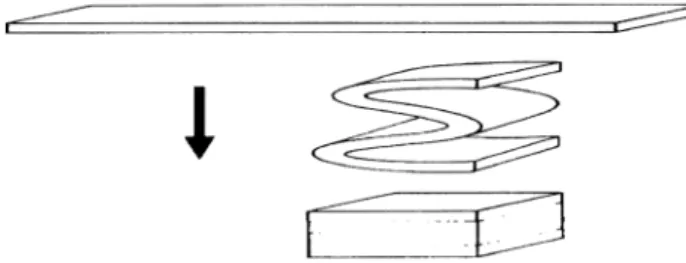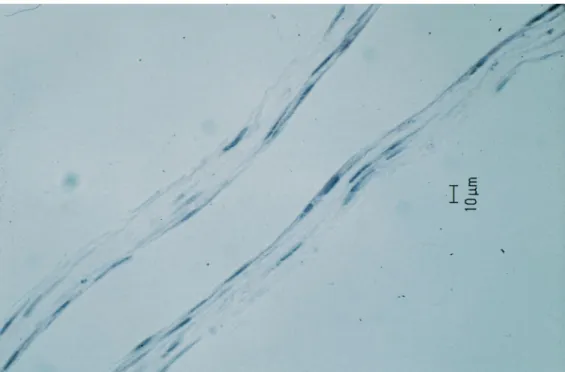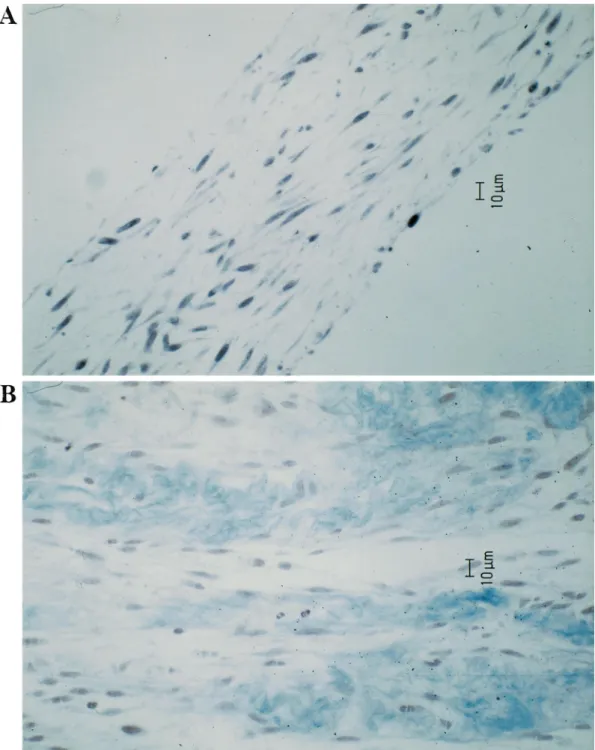Tissue engineering in cardiovascular surgery: new approach to develop
completely human autologous tissue
q
Qing Ye
a, Gregor ZuÈnd
b,*, Stefan Jockenhoevel
a, Simon P. Hoerstrup
b, Andreina Schoeberlein
b,
Jurg Grunenfelder
b, Marko Turina
baDepartment of Surgical Research, University Hospital, RaÈmistrasse 1000, CH-8091, Zurich, Switzerland bClinic for Cardiovascular Surgery, University Hospital, RaÈmistrasse 100, CH-8091 Zurich, Switzerland
Received 7 September 1999; received in revised form 19 January 2000; accepted 26 January 2000
Abstract
Objective: In cardiovascular tissue engineering, three-dimensional scaffolds serve as physical supports and templates for cell attachment and tissue development. Currently used scaffolds are still far from ideal, they are potentially immunogenic and they show toxic degradation and in¯ammatory reactions. The aim of this study is to develop a new method for a three-dimensional completely autologous human tissue without using any scaffold materials. Methods: Human aortic tissue is harvested from the ascending aorta in the operation room and worked up to pure human myo®broblasts cultures. These human aortic myo®broblasts cultures (1.5 £ 106cells, passage 3) were seeded into 15-cm
culture dishes. Cells were cultured with Dulbecco' s modi®ed Eagle's medium supplemented with 1 mM l-ascorbic acid 2-phosphate for 4 weeks to form myo®broblast sheets. The harvested cell sheets were folded to form four-layer sheets. The folded sheets were then framed up and cultured for another 4 weeks. Tissue development was evaluated by biochemical assay and light and electron microscopy. Results: After 4 weeks of culture in ascorbic acid supplemented medium, myo®broblasts formed thin cell sheets in culture dishes. The cell sheets presented in a multi-layered pattern surrounded by extracellular matrices. Cultured for additional 4 weeks on the frames, the folded sheets further developed into more solid and ¯exible tissues. Light microscopy documented a structure resembling to a native tissue with con¯uent extracellular matrix. Under transmission electron microscope, viable cells and con¯uent bundles of striated mature collagen ®bers were observed. Hydroxyproline assays showed signi®cant increase of collagen content after culturing on the frames and were 80.5% of that of natural human pericardium. Conclusions: Improved cell culture technique may render human aortic myo®broblasts to a native tissue-like structure. A three-dimensional completely autologous human tissue may be further developed on the base of this structure with no show toxic degradation or in¯ammatory reactions. q 2000 Elsevier Science B.V. All rights reserved.
Keywords: Tissue engineering; Autologous human tissue; Cardiovascular; Scaffolds
1. Introduction
Tissue engineering may provide an alternative to organ and tissue transplantation, because of the limited supply of donor organs [1]. Most common mode of engineering new tissue is based on seeding isolated cells on a three-dimen-sional scaffold followed by in vitro culture. The scaffolds serve as physical supports and templates for cell attachment and tissue development. With the principles of tissue engi-neering, researchers are trying to create new tissue in cardi-ovascular surgery, such as heart valves, cardiac muscle, pericardium and vessels [2±6].
The currently used materials for maintaining
three-dimensional structures in tissue engineering are either poly-mers composed of chemical substances like polyglycolic acid, polyhydroxybutyrate and gels out of extracellular matrix proteins such as collagen [7,8]. Unfortunately, these materials are still far from ideal. They are expensive, potentially immunogenic and further more they show toxic degradation and in¯ammatory reactions. In addition they might be of poor resorbability [8±11].
Collagen is a major component of various tissue in cardi-ovascular system, such as heart valve and pericardium [12,13]. Considered to be the main stress bearing compo-nent, it has been the focus of most studies about heart valve or pericardial tissue engineering. The collagen is produced by ®broblast cells. In long-term postcon¯uent ®broblasts cultures, connective tissue matrix is produced with many in vivo-like properties including supermolecular organiza-tion of collagen. Collagen is not only processed essentially complete, but is also cross-linked ef®ciently and the
1010-7940/00/$ - see front matter q 2000 Elsevier Science B.V. All rights reserved. PII: S1010-7940(00)00371-7
www.elsevier.com/locate/ejcts
qPresented at the 13th Annual Meeting of the European Association for
Cardio-thoracic Surgery, Glasgow, Scotland, UK, September 5±8, 1999. * Corresponding author. Tel.: 141-1-255-3801; fax: 141-1-255-4369. E-mail address: gregor.zund@chi.usz.ch (G. ZuÈnd)
collagen ®brils are assembled into bundles [14]. The long-term culture forms a three-dimensional structure with the ®broblasts settle in the self-produced extracellular matrix [15]. The formed three-dimensional structure might serve as a template for further tissue development.
The aim of this study is to develop a new method for a three-dimensional completely autologous human tissue without using any scaffold materials.
2. Material and methods
2.1. Human aortic myo®broblast cell expansion
Human ascending aortic tissue was collected in the opera-tion room. After harvesting, the explants were rinsed with phosphate-buffered saline (PBS) and stripped off adventitia. The tissue was then cut into small pieces of 2 £ 2 mm for primary culture in Dulbecco's modi®ed Eagle's medium supplemented with 10% fetal bovine serum and 1% strepto-mycin (Gibco BRL-Life Technologies, Grand Island, NY). After 3±4 weeks, human aortic myo®broblasts grew into con¯uent monolayers and were serially passaged by trypsi-nization (trypsin/EDTA solution, 0.05%/0.02%, Gibco BRL-Life Technologies, 3±5 min) and subcultured to obtain suf®cient cell numbers for cell seeding (passage 3±4). 2.2. Cell sheets culture and tissue development
The myo®broblasts were cultured in 15-cm culture dishes for 4 weeks with Dulbecco's modi®ed Eagle's medium, supplemented with 10% fetal bovine serum and 1% strepto-mycin (Gibco BRL-Life Technologies, Grand Island, NY), 1.0 mmol/l l-ascorbic acid 2-phosphate (Asc 2-P, Sigma Chemical Co, St. Louis, MO). Cell sheets formed after 4 weeks of culture and were detached from the culture dish. These cell sheets were folded into four-layer sheets (Fig. 1) and mounted on culture frames (diameter 1.5 cm). The framed cell sheets were cultured for another 4 weeks in the same medium.
2.3. Structure assessment 2.3.1. Collagen content
Collagen content was estimated with hydroxyproline (Hyp) assay according to Reddy et al. [16]. Brie¯y, samples
were lyophilized and hydrolyzed with 2 M NaOH. Hydro-lyzed free hydroxyproline was oxidized with chloramine-T and the addition of Ehrlich's reagent resulted in the forma-tion of a chromophore. It's absorbance measured at 550 nm. The hydroxproline content of the cell sheets and framed sheets were compared human pericardium.
2.3.2. Histological evaluation
Specimens for light microscope examination were ®xed in 4% formalin, embedded in paraf®n and sectioned. The sec-tions were stained by hematoxylin and eosin (HE) or Mas-son's trichrome. Transmission electron microscopy speci-mens were ®xed with Na-Cacodylat-buffered glutaraldehyde (2.5%) and paraformaldehyde (0.8%), and were post-®xed with 1% osmium tetroxide, dehydrated in a series of alcohol, and embedded. Ultra-thin sections were stained with uranyl acetate and lead citrate. The specimens were observed under light microscopy and transmission electron microscopy. 2.3.3. Statistics
Results data were expressed as mean ^ 1 SD. Compar-isons between groups were performed by ANOVA test. Statistical signi®cance was set at P , 0:05.
3. Results
After 4 weeks of culture in Asc 2-P supplemented medium, human ascending aortic myo®broblasts formed thin cell sheets in the culture dishes and were detached from the culture dish. The cell sheets measured about 20 mm in thick-ness under microscope, and were presented in a multilayer pattern surrounded by extracellular matrix (Fig. 2). In contrast, myo®broblasts cultured in medium without Asc 2-P remained as a cell monolayers and could hardly be detached from the culture dish. The harvested cell sheets were folded to form four-layer cell sheets and were cultured for additional 4 weeks on the frames, the folded sheets further developed into more solid and ¯exible tissues (Fig. 3). With regard to the mechanical properties, the tissue is ¯exible and elastic. An excursion of the framed tissue to 10 mm without rupture was possible. Light microscopy documented an inte-gral structure resembling to a native tissue structure with con¯uent extracellular matrix, measuring about 150 mm in thickness (Fig. 4A,B). Under transmission electron micro-scope, active viable cells and con¯uent bundles of striated mature collagen ®bers were observed (Fig. 5A,B).
Hydroxyproline content (Hyp/tissue dry weight) of folded cell sheets was signi®cantly higher than that of the cell sheets before folding (6.012 ^ 0.197 vs. 4,387 ^ 0.349 mg/mg, P , 0:01) (Fig. 6). Folded cell sheets had a hydro-xyproline content of 80.5% of human pericardium, while the cell sheets before folding has only 58.7%. These assay results showed, that the folded cell sheets on the frames were further growing and producing more collagen and a continuous tissue development was achieved.
Q. Ye et al. / European Journal of Cardio-thoracic Surgery 17 (2000) 449±454 450
Fig. 1. Illustration of cell sheets folding. A piece of cell sheet harvested from the 15-cm culture dish was folded to form a four-layer sheet.
4. Discussion
The currently used materials for maintaining three-dimensional structures in tissue engineering are either poly-mers composed of chemical substances like polyglycolic
acid, polyhydroxybutyrate and gels out of extracellular matrix proteins such as collagen. Unfortunately, these mate-rials are still far from ideal, they are expensive, potentially immunogenic and furthermore they show toxic degradation and in¯ammatory reactions, in addition they might be of
Fig. 3. Folded cell sheets developed into a solid and ¯exible tissues on the frame.
Fig. 2. After 4 weeks of culture in Asc 2-P supplemented medium, human ascending aortic myo®broblasts a multilayer cell sheet with cells surrounded by extracellular matrix (hematoxylin and eosin staining).
poor resorbability. Thus, the ®nal goal of the presented study is to demonstrate a new method, which allows the creation of a three-dimensional new tissue without any disadvantages of the common used scaffolds. Furthermore we demonstrate a core structure which might be used for further application in the cardiovascular tissue engineered ®eld.
Hata et al. [17] ®rst demonstrated that supplementation of ®broblast cell cultures with Asc 2-P stimulates the accumu-lation of intact collagen which leads to the formation of
mature ECM. Ascorbic acid is an essential cofactor for the hydroxylation of proline and lysine residues in collagens synthesized by human ®broblasts. Ascorbic acid is also known to increase the transcriptional rate of procollagen genes and the stability of procollagen mRNA [18,19] as well as to modulate growth properties of cells [20]. Grinnel et al. [14] found accelerated collagen assembly in extracel-lular matrix by ®broblasts in long-term cultures supplemen-ted with ascorbic acid. The matrix was highly differentiasupplemen-ted as shown by complete processing of procollagen to collagen
Q. Ye et al. / European Journal of Cardio-thoracic Surgery 17 (2000) 449±454 452
Fig. 4. Light microscopy documented folded cell sheets developed into an integral structure resembling to a native tissue with viable cells and con¯uent extracellular matrix. (A) Hematoxylin and eosin staining, (B) Masson's trichrome staining.
and the assembly of collagen ®brils into bundles. We have similar results in this study, after 8 weeks culture in Asc 2-P supplemented medium, extracellular matrix accumulated around the cells, and bundles of collagen with mature striated appearance were observed by transmission electron microscopy.
Mechanical stress enhances synthesis and secretion of proteins and mechanical stiffness, and effects on the level of gene expression. Tension as a speci®c form of mechan-ical stress affects the cell function and behavior [21]. Connective tissue morphogenesis was induced by isometri-cally strained ®broblast cultures. In our previous study, when seeded PGA meshes were cultured under certain tension on the culture frame, production of collagen by the myo®broblasts was signi®cantly increased. Hydroxypro-line content was more that six times higher in the framed cultures compared with the unframed, and even ten times higher compared with the unframed cultures with ascorbic [22]. In this study, we modi®ed our framework and mounted the folded four-layer cell sheets on the frames so as to perform tension on the sheets to stimulate extracellular matrix generation.
When the cell sheets are framed up, not only mechanical tension is achieved, but in addition, the framed cell sheets are in good contact with medium on both surfaces, this will greatly facilitating the nutrition supply to the inner part of
the structure. Histological study shows low necrosis even in the core part of the structure. The thickness of the tissue we have developed was about 150 mm, which is much thicker than the simple addition of four cell layers before culturing. Moreover, the folded cell sheets had a signi®cantly higher hydroxproline contents compared to the cell sheets before folding. These results suggest the harvested tissue is viable and has the ability of further growing under in vitro culture
Fig. 5. (A) Active viable cells and con¯uent bundles collagen were observed by transmission electron microscope, (B) the collagen ®bers are highly striated at high magni®cation.
Fig. 6. Hydroxyproline content (Hyp/tissue dry weight) of folded cell sheets was signi®cantly higher than that of the cell sheets before folding (P , 0:01). They contain 80.5 and 58.7% Hyp content in comparison with human pericardium.
conditions. In addition, the presented new method is poten-tially not immunogenic and showed no toxic degradation or even in¯ammatory reactions.
An improvement of the mechanical properties might be possible by higher folding cycles. More investigations are necessary to characterize the mechanical properties subject to the number and time intervals of folding cycles. Never-theless at that moment the tissue is strong enough to be implanted as a arti®cial pericardium. By the production of a thicker and stiffer tissue sheet the construction of cardiac valves will be possible in a surgical technique like the manufacture of pericardium valves.
In conclusion, improved cell culture technique may render human aortic myo®broblasts to a native tissue-like structure. A autologous tissue in the cardiovascular ®eld might be of further development based on the presented core structure.
References
[1] Kim BS, Mooney DJ. Development of biocompatible synthetic extra-cellular matrices for tissue engineering. Trends Biotechnol 1998;16:224±230.
[2] Shinoka T, Breuer CK, Tanel RE, ZuÈnd G, Miura T, Ma PX, Langer R, Vacanti JP, Mayer JE. Tissue engineering heart valves: valve lea¯et replacement study in a lamb model. Ann Thorac Surg 1995;60:S513±S516.
[3] Shinoka T, Ma PX, Shum Tim D, Breuer CK, Cusick RA, ZuÈnd G, Langer R. Tissue engineering heart valves: autologous valve lea¯et replacement in a lamb model. Circulation 1996;94(Suppl II):II164± II168.
[4] Shinoka T, Shum Tim D, Ma PX, Tanel RE, Isogai N, Langer R, Vacanti JP, Mayer Jr JE. Creation of viable pulmonary artery auto-grafts through tissue engineering. J Thorac Cardiovasc Surg 1998;115:536±545.
[5] Zund G, Breuer CK, Shinoka T, Ma PX, Langer R, Mayer JE, Vacanti JP. The in vitro construction of a tissue engineered bioprosthetic heart valve. Eur J Cardio-thorac Surg 1997;11:493±497.
[6] Zund G, Hoerstrup SP, Schoeberlein A, Lachat M, Uhlschmid G, Vogt PR, Turina M. Tissue engineering: a new approach in cardio-vascular surgery; seeding of human ®broblasts followed by human endothelial cells on resorbable mesh. Eur J Cardio-thorac Surg 1998;13:160±164.
[7] Freed LE, Vunjak Novakovic G, Biron RJ, Eagles DB, Lesnoy DC, Barlow SK, Langer R. Biodegradable polymer scaffolds for tissue engineering. Biotechnol NY 1994;12:689±693.
[8] Grande DA, Halberstadt C, Naughton G, Schwartz R, Manji R. Evaluation of matrix scaffolds for tissue engineering of articular carti-lage grafts. J Biomed Mater Res 1997;34:211±220.
[9] Sims CD, Butler PE, Cao YL, Casanova R, Randolph MA, Black A, Vacanti CA, Yaremchuk MJ. Tissue engineered neocartilage using plasma derived polymer substrates and chondrocytes. Plast Reconstr Surg 1998;101:1580±1585.
[10] Zibaitis A, Greentree D, Ma F, Marelli D, Duong M, Chiu RC. Myocardial regeneration with satellite cell implantation. Transplant Proc 1994;26:3294.
[11] Greentree D, Marelli D, Ma F, Chiu RC. Satellite cell transplantation for myocardial repair: labeling techniques. Transplant Proc 1994;26:3357.
[12] Scott M, Vesely I. Aortic valve cusp microstructure: the role of elas-tin. Ann Thorac Surg 1995;60:S391±S394.
[13] Ishihara T, Ferrans VJ, Jones M, Boyce SW, Kawanami O, Roberts WC. Histologic and ultrastructural features of normal human parietal pericardium. Am J Cardiol 1980;46:744±753.
[14] Grinnell F, Fukamizu H, Pawelek P, Nakagawa S. Collagen proces-sing, crosslinking, and ®bril bundle assembly in matrix produced by ®broblasts in long-term cultures supplemented with ascorbic acid. Exp Cell Res 1989;181:483±491.
[15] Ishikawa O, Kondo A, Okada K, Miyachi Y, Furumura M. Morpho-logical and biochemical analyses on ®broblasts and self-produced collagens in a novel three-dimensional culture. Br J Dermatol 1997;136:6±11.
[16] Reddy GK, Enwemeka CS. A simpli®ed method for the analysis of hydroxyproline in biological tissues. Clin Biochem 1996;29:225±229. [17] Hata R, Senoo H. L-ascorbic acid 2-phosphate stimulates collagen accumulation, cell proliferation, and formation of a three-dimensional tissue-like substance by skin ®broblasts. J Cell Physiol 1989;138:8± 16.
[18] Lyons BL, Schwarz RI. Ascorbate stimulation of PAT cells causes an increase in transcription rates and a decrease in degradation rates of procollagen mRNA. Nucleic Acids Res 1984;12:2569±2579. [19] Tajima S, Pinnell SR. Regulation of collagen synthesis by ascorbic
acid. Ascorbic acid increases type I procollagen mRNA. Biochem Biophys Res Commun 1982;106:632±637.
[20] Hata R, Sunada H, Arai K, Sato T, Ninomiya Y, Nagai Y, Senoo H. Regulation of collagen metabolism and cell growth by epidermal growth factor and ascorbate in cultured human skin ®broblasts [published erratum appears in Eur J Biochem 1988 Aug 15;175(3):679]. Eur J Biochem 1988;173:261±267.
[21] Kanda K, Matsuda T, Oka T. Mechanical stress induced cellular orientation and phenotypic modulation of 3-D cultured smooth muscle cells. ASAIO J 1993;39:M686±M690.
[22] Hoerstrup SP, Zund G, Ye Q, Schoeberlein A, Schmid AC, Turina M. Tissue engineering of a bioprosthetic heart valve: stimulation of extracellular matrix assessed by hydroxyproline assay. ASAIO J 1999;45(5):397±402.
Q. Ye et al. / European Journal of Cardio-thoracic Surgery 17 (2000) 449±454 454



